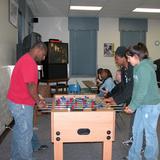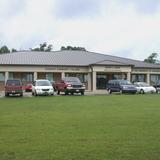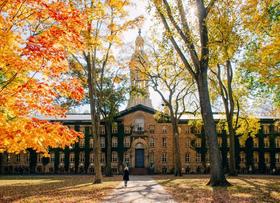- The University of Arkansas Community College at Hope is an accredited, open-access, two-year institution of higher education committed to providing quality academic, occupational, personal growth, and cultural programs to support individual student and community needs in the Southwest Arkansas area.
School Highlights
University of Arkansas Hope-Texarkana serves 1,561 students (32% of students are full-time).
The college's student-teacher ratio of 10:1 is lower than the state community college average of 13:1.
Minority enrollment is 45% of the student body (majority Black), which is more than the state average of 39%.
Quick Facts (2026)
- Enrollment: 1,561 students
- In-state tuition: $2,431
- Out-state tuition: $4,396
- Student-teacher ratio: 10:1
- Minority enrollment: 45%
- Source: Integrated Postsecondary Education Data System (IPEDS)
Top Rankings
University of Arkansas Hope-Texarkana ranks among the top 20% of public schools in Arkansas for:
Category
Attribute
Diversity
School Overview
The teacher population of 150 teachers has stayed relatively flat over five years.
University of Arkansas Hope-Texarkana
(AR) Community College Avg.
Carnegie Classification
Associate's Colleges: Mixed Transfer/Career & Technical-Mixed Traditional/Nontraditional
Associate's Colleges: High Transfer-Mixed Traditional/Nontraditional
Institution Level
At least 2 but less than 4 years
At least 2 but less than 4 years
Institution Control
Public
Public
Year Founded
1965
Total Faculty
150 staff
165 staff
School Calendar
Student Body
The student population of University of Arkansas Hope-Texarkana has grown by 28% over five years.
The student-teacher ratio of 10:1 has decreased from 22:1 over five years.
The University of Arkansas Hope-Texarkana diversity score of 0.59 is more than the state average of 0.58. The school's diversity has grown by 6% over five years.
Total Enrollment
1,561 students
1,653 students
Student-Teacher Ratio
10:1
13:1
# Full-Time Students
503 students
595 students
# Part-Time Students
1,058 students
1,058 students
# Enrollment Undergraduate
156 students
194 students
# Full-Time Undergraduate Students
503 students
595 students
# Full-Time Graduate Students
n/a
15 students
# Part-Time Undergraduate Students
1,058 students
1,055 students
# Part-Time Graduate Students
n/a
38 students
Total Dormitory Capacity
n/a
160 students
% American Indian/Alaskan
n/a
1%
% Asian
1%
2%
% Hispanic
9%
11%
% Black
31%
18%
% White
55%
61%
% Hawaiian
n/a
1%
% Two or more races
3%
4%
% Non Resident races
n/a
1%
% Unknown races
n/a
1%
Diversity Score
0.59
0.58
College Completion Rate (Students who graduate in less than 4 years)
42%
36%
College Completion Rate (Students who graduate in 4 years or more than 4 years)
n/a
31%
Average Graduate Earnings (10 Years)
$26,300
$28,600
Tuition and Acceptance Rate
The public in-state tuition of $2,431 is less than the state average of $2,994. The in-state tuition has declined by 25% over four years.
The public out-state tuition of $4,396 is less than the state average of $4,750. The out-state tuition has stayed relatively flat over four years.
In-State Tuition Fees
$2,431
$2,994
Out-State Tuition Fees
$4,396
$4,750
Tuition Notes
Tuition calculator available at: www.uaht.edu
% Students Receiving Some Financial Aid
98%
94%
Median Debt for Graduates
$2,250
$9,500
Median Debt for Dropouts
$3,013
$5,000
Acceptance Rate
n/a
100%
SAT Reading
n/a
540
SAT Math
n/a
520
SAT Writing
n/a
515
ACT Composite
n/a
22
ACT English
n/a
22
ACT Math
n/a
21
Source: 2024 (or latest year available) Integrated Postsecondary Education Data System (IPEDS) , School Administrators
School Notes
- School Mascot: Iron Horse
- Founded in 1965 as Red River Vocational-Technical School, the school officially became Red River Technical College in 1991 and operated under the guidelines of the Arkansas Department of Higher Education. In 1996, Red River Technical College became a division of the University of Arkansas System and was renamed the University of Arkansas Community College at Hope. The campus is set among the pines of a beautiful 72-acre tract in the heart of Southwest Arkansas. State-of-the-art facilities and the latest technological equipment are just a few of the advantages you find on the campus at UACCH. The University of Arkansas Community College at Hope has more than 100 professional educators on its faculty and staff. The foundation of the college's commitment to academic excellence is our experienced and dedicated faculty. The University of Arkansas Community College at Hope (UACCH) seeks to redefine human potential by making technology and information a regular part of the lives of people with disabilities. UACCH is accomplishing this by raising public awareness and implementing programs and initiatives that provide access to conventional, assistive and information technologies, related services and resources.
Frequently Asked Questions
How much does University of Arkansas Hope-Texarkana cost?
University of Arkansas Hope-Texarkana's tuition is approximately $2,431 for In-State students and $4,396 for Out-State students.
What is University of Arkansas Hope-Texarkana's ranking?
University of Arkansas Hope-Texarkana ranks among the top 20% of community college in Arkansas for: Diversity in US community colleges.
Recent Articles

Most In-Demand Community College Majors for 2025–26
Explore the most in-demand community college majors for 2025–26 workforce needs, aligned with hiring trends, wages, and transfer pathways.

New Guidebook Helps Students Navigate Community College
A new guidebook offers practical strategies to help students and families succeed in community college, from admissions to transfer and career planning.

Work-Study Opportunities for Spring 2026 Guide
Learn how to secure work-study opportunities for Spring 2026 before classes start, including timelines, tips, and eligibility guidance.











